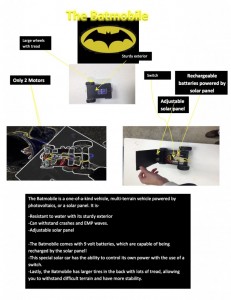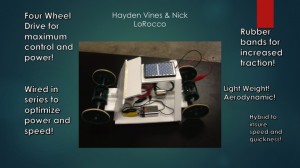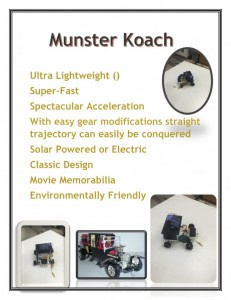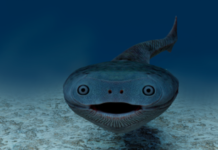Ultra-lightweight racers zipped around the room as students in PMM Engineering presented their solar cars on Tuesday, November 4. The cars demonstrated students’ comprehension of renewable energy and tested their ability to apply it on a practical level.
PMM Engineering highlights petroleum, biomedical, and mechanical engineering. As a precursor to petroleum engineering, students learn about alternate energy forms. The class covers nuclear fission, fusion, and the propagation of nuclear power plants, as well as various types of renewable energy forms.
 In addition to studying how these forms of energy work, students learn about their present and future applications. For example, Mrs. Julie Carver stated, “We talk about the difficulty of integrating alternate energy forms into the grid. We talk about where different places are in terms of renewable energy. Germany is at fifty percent solar.” Students also investigate the fracking debate in Denton and the solar initiative in Plano. Finally, students build solar cars at the end of the alternate energy section.
In addition to studying how these forms of energy work, students learn about their present and future applications. For example, Mrs. Julie Carver stated, “We talk about the difficulty of integrating alternate energy forms into the grid. We talk about where different places are in terms of renewable energy. Germany is at fifty percent solar.” Students also investigate the fracking debate in Denton and the solar initiative in Plano. Finally, students build solar cars at the end of the alternate energy section.
This unit’s final project, the solar car, ties multiple fields together. Mrs. Carver stated, “It’s a unique capstone. It’s a link between mechanical—we review gears. We review center of gravity, alignment issues, and forces—and the energy unit where we talk about renewable energy forms.”
Students must design and construct their own solar cars. They are judged on distance traveled, quality of movement, consistency, velocity attained, total weight, and innovation of design. Students must calculate important factors such as efficiency, traction, power output, and drag. After designing unique cars, students must construct their cars and test for real-world results. Students often need to make adjustments before the finished product can be judged. Finally, students create flyers that advertise their final cars.
Seniors learned valuable skills they will carry for the rest of their lives. Nicholas LoRocco ’15 stated that he “learned just how complex wiring can be as well as just how important wiring batteries in series can be.” In addition, many students, including Tristan Hitt ’15, learned valuable lessons: “This project has taught me the importance of how a particular concept works. I needed to know how everything worked in tandem and produced the desired end result.”
The Solar Car Project demonstrates the unique hands-on experience that PMM Engineering offers. It is truly a unique class that will continue to introduce students to the world of engineering.








